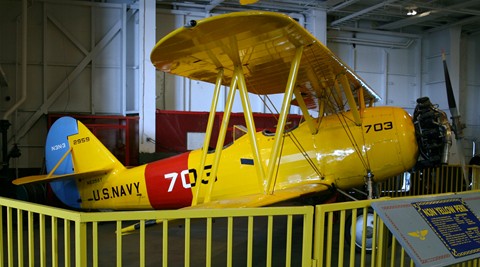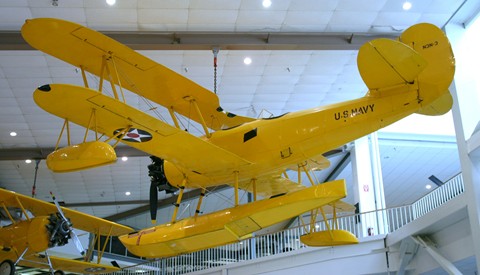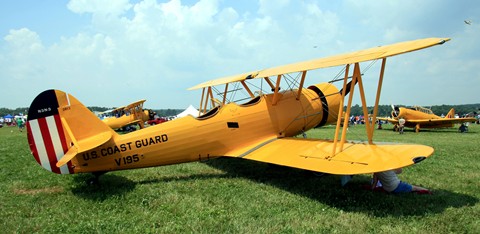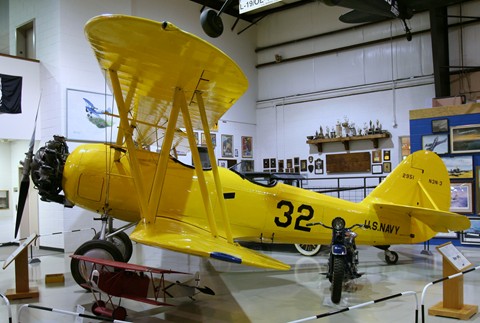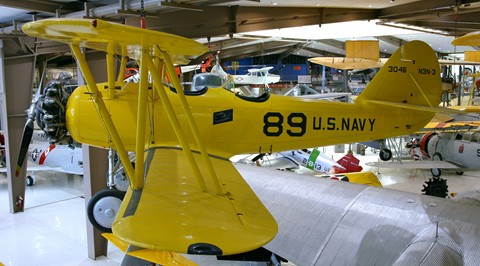|
N3N CanaryThe N3N Canary was a US Navy basic trainer produced by its own aircraft manufacturing company called the Naval Aircraft Factory (NAF). BackgroundAs the US entered World War I, most of the government expenditures for aircraft were used for the Army. The US Navy had to scratch and claw to get its aviation requirements noticed. When the US Navy did receive funds to supply itself with aircraft, it was hard to find a manufacturer interested in making them. US aircraft manufacturers were more interested in the large volume orders the Army was placing. If they could build their own ships, the Navy figured they could build their own aircraft, and thus was established the Naval Aircraft Factory (NAF) in Philadelphia, PA, in 1918. The NAF was the only government owned aircraft company in US history.
Photo above, taken by Horace Sagnor, shows an N3N-3 (2959, N6358T) on display at the USS Lexington museum in Corpus Christi, TX. DevelopmentIn 1934 the US Navy was looking for a trainer to replace the obsolete Consolidated NY-2 and NY-3. The Stearman funded prototype NS-1, which would become the infamous Kaydet, was still being tested. The Navy inventory had a supply of Wright J-5 220-hp radial engines. Why not use them. Since they had their own aircraft factory they decided to have the NAF design their new trainer using the surplus engines. First PrototypeThe NAF settled on a simple, rugged design with an all-metal main structure. Its fuselage was comprised of metal tubing bolted together making for a strong airframe. It was dubbed the Canary. On the port (left) side of the aircraft were removable side panels for ease of maintenance. From the front of the aircraft back to the firewall in the cockpit the frame was covered with metal, as was the vertical stabilizer. Everything else was covered with fabric. In August 1935, prototype XN3N-1 was flight tested both at Philadelphia and NAS Anacostia, MD (no longer exists). Testing was done with landing gear and floats. Satisfied with test results, the Navy contracted the NAF to produce 179 N3N-1s. The first aircraft was delivered in June 1936.
The National Museum of Naval Aviation in Pensacola, FL has two Canarys on display. Photo above shows the more conventional land based N3N-3 (3046). Second and Third PrototypeA second prototype, the XN3N-2, was built using the Navy's own engine, a variant of the Wright J-6-7 designated the R-760-96, which was rated at 240hp. Eventually, however, all N3N-1s would be retrofitted with a new Wright R-760-2. With the completion of the initial production order of the N3N-1 in 1938, the NAF set about improving the design by deepening the rear fuselage, redesigning the tail surfaces, and adding a single strut landing gear which eliminated a complex landing gear arrangement on earlier models. Another modification was one of convenience. Originally, the N3N had a cowling around the engine to reduce drag, but the cowling was left off so much during service, that it was finally eliminated from future designs. Speed was not a primary goal of trainers. ProductionSince the Navy was delighted with the changes and impressed with the new R-760-2 engine, a contract was processed for 816 N3N-3s. Included in this total were four N3N-3s (V193-V196) that were built for the US Coast Guard. One of these Coast Guard survivors is shown below (V195). Photo taken by Horace Sagnor at the 2008 Geneseo Air Show.
'Yellow Peril'Though the official name was the Canary, aviators nicknamed all trainers of the era ‘Yellow Peril’, which had nothing to do with design, performance, or manufacture of trainer aircraft. If a cadet could not solo in a specified amount of time he was in peril of not becoming an aviator. As time went on, the ‘Yellow Peril’ tag became synonymous with the Canary. Service LifeDuring the war years, some 65,000 Navy pilots were trained, with most of them learning to fly in the Canary. In the late years of the war, the trainer was replaced by the Stearman N2S Kaydet, yet the Canary would outlive the Kaydet in naval service. While the Stearman was retired in 1948, the 'Yellow Peril' lived on for another 13 years at the US Naval Academy where midshipmen learned the basics of aviation flying seaplane versions of the N3N-3. The last Canary was retired at the Naval Academy in 1961. The photos below show the seaplane variant of the Canary (2693) at the National Museum of Naval Aviation, Pensacola, FL. Bottom photo by Horace Sagnor.
A New LifeSurplus Canarys could be purchased for $500 after WWII so many were snapped up and modified for use as crop dusters and sprayers. Some Yellow Perils were fitted with water tanks and doors, and thus became some of the earliest fire bombers ever flown. As agricultural became more sophisticated, most Canarys were abandoned. It was the warbird movement that saw aircraft collectors restore the crop dusters back to their original naval trainer state. Many of these fly at air shows across the country, and many more can be seen at numerous aviation museums like we display here. Enjoy them. Appreciate their journey. And the next time some air show know-it-all says, “Nice Stearman”, tap him on the shoulder and say, “No, I believe that’s a Canary”. Navigation IndexReturn to the top of this N3N Canary page
|
